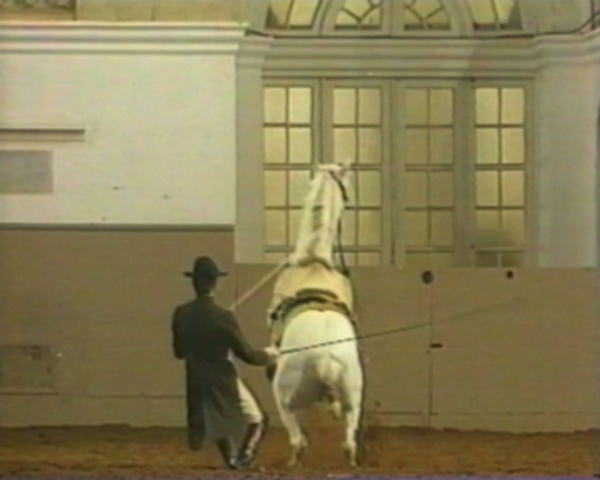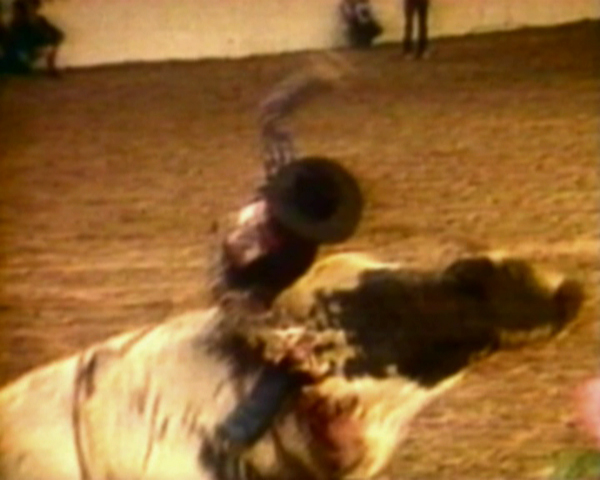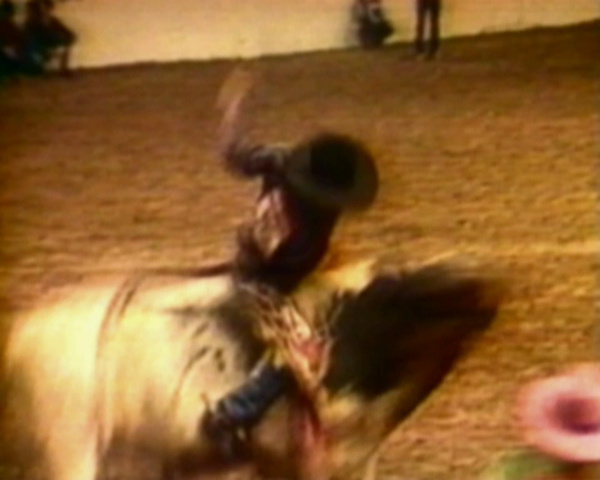nives widauer

Nives Widauer: Slipping, 2006
Videoloop; courtesy of the artist, Galerie Ernst Hilger, Vienna and galerie semina rerum, Zurich

Nives Widauer: ro-d-eo, 2007
Videoloop; courtesy of the artist, Galerie Ernst Hilger, Vienna and galerie semina rerum, Zurich

Nives Widauer: ro-d-eo, 2007
Videoloop; courtesy of the artist, Galerie Ernst Hilger, Vienna and galerie semina rerum, Zurich

Nives Widauer: ro-d-eo, 2007
Videoloop; courtesy of the artist, Galerie Ernst Hilger, Vienna and galerie semina rerum, Zurich

Nives Widauer: ro-d-eo, 2007
Videoloop; courtesy of the artist, Galerie Ernst Hilger, Vienna and galerie semina rerum, Zurich

Nives Widauer: ro-d-eo, 2007
Videoloop; courtesy of the artist, Galerie Ernst Hilger, Vienna and galerie semina rerum, Zurich
On slipping and on ro-de-o, two video loops originated in the course of an investigation into the moment of loss of equilibrium as exemplified by human-animal relations:
In 2003, in the course of preparations for a video stage space for "Ein Sportstück" by Elfriede Jelinek for the Zurich Festival, I ventured a foray, actually several forays into image archives, looking for moving testimonial of the moments of loss of equilibrium. This gave rise, over the next years, to around a dozen looped and dynamically slowed down, re-rhythmified videos which I combine under the title balanced/disbalanced.
What is fascinating about these image sequences is that we can witness how the illusion of wanting to control gravity and its effects on the body repeatedly turns into its opposite and how we nonetheless watch in disbelief when a sequence of movements gets out of step.
The momements of dissolution of the normal exert magical attraction: especially when the act of failing is linked not only to our human body, but to a sequence of movements not immanent to us.
In this case teh power of a horse (slipping) about to leap, that cannot freely yield to its energy but hangs on the bridle of its rider and thus by a hair's breadth, utterly untypical for a horse, is about to lose its equilibrium, which in turn causes the fall of the putative dominator. The slowness of the toppling has a hypnotic effect. The expectation of the fall remains unfulfilled.
Or, as becomes visible in rodeo riding, this becomes enhanced by slowing down the image, how the mass of the animal rotating to get rid of the foreign body on its back builds up an charge of energy that lets the rider appear like a playball of the elements.
I would like to append a few sentences on human-animal relations by the French philosopher Michel de Montaigne (from: Michel de Montaigne, "An Apology of Raymond Sebond", in: The Works of Michel de Montaigne, 1865, translated by William Hazlitt):
"Presumption is our natural and original disease. The most wretched and frail of all creatures is man, and withal the proudest. He feels and sees himself lodged here in the dirt and filth of the world, nailed and rivetted to the worst and deadest part of the universe, in the lowest story of the house, the most remote from the heavenly arch, with animals of the worst condition of the three; and yet in his imagination will be placing himself above the circle of the moon, and bringing the heavens under his feet.
'Tis by the same vanity of imagination that he equals himself to God, attributes to himself divine qualities, withdraws and separates himself from the crowd of other creatures, cuts out the shares of the animals, his fellows and companions, and distributes to them portions of faculties and force, as himself thinks fit. How does he know, by the strength of his understanding, the secret and internal motions of animals? — from what comparison betwixt them and us does he conclude the stupidity he attributes to them?
When I play with my cat, who knows whether I do not make her more sport than she makes me? We mutually divert one another with our play. If I have my hour to begin or to refuse, she also has hers.
On the works of Nives Widauer
For years, Nives Widauer’s artistic work has been moving between two poles that mutually influence her oeuvre and her projects. On the one hand, there is her work in the opera and the theater, where Widauer created a sensation in 1990 with a video stage design for Theater Basel, integrating video and audiovisual production techniques she mastered as a student directly into the performance onstage in a completely innovative way. Her collaboration with various theaters and stage directors, as well as the resulting multimedia scenographies, has since been an important integral part of her work. On the other hand, since the beginning of the 1990s, Widauer has been developing an artistic oeuvre that comprises, among other things, single channel videos, large-scale (video) installations, objects made of paper, as well as photographic works and objects. With her work, the artist consistently explores the transitions between the fine arts, literature and the performing arts. Language and image, text and animation, time and space are, in a sense, the parameters that she investigates in the different media. In doing so, Widauer deliberately blurs the borders between the various artistic genres, or blends them. As a case in point, in a group of video works, she poses the question of the link between literature and scholarly writing, between language and images. In the two videos “Sie nahten sich mir ganz ohne Scheu” (1998) and “Todesfuge” (1999) (“They Approached Me without Any Fear,” 1998; and “Death Fugue,” 1999), the linguistic and visual interpretation of literary texts are intertwined. The poems (Heinrich Heine’s “Forest Solitude” and Paul Celan’s “Death Fugue”) are interpreted from several angles by narrators, as well as the artist, who integrates the recitation in an audiovisual scenography. While the text and images, the audiovisual and textual narrative flow are congruent in this work, “Philosoccer” (2007–2008) revolves around the phenomenon of a lack of understanding. Soccer players move their lips devoutly, but instead of hearing the national anthems they expect to hear, listeners are presented with quotes from philosophical treatises that come across as absurd wordings, as an alienating, Babylonian confusion of tongues interspersed with original TV recordings of the crowd hooting and clapping. On principle, the discovery and experience of specific realities constitutes the starting point of Widauer’s artistic research, in which the traces of personal experience and the recollection of partly unspectacular situations is accorded a central significance. She responds to these themes with a poetic, individual (pictorial) language, which always holds surprises in store and links moments of her daily life – subjective impressions and experiences – with universal and general issues. In their infinitely repetitious slapstick scenes, prototypical microstudies such as the series “Vienna-Loops” (from 2007) not only display individual failures of the protagonists (dancing couples in their finery and horse shows) but at the general level also point out the painful little mishaps common to us all. The “belief in the power of little things,” to quote Widauer, in the powerful effect of everyday things, also characterizes the 2008 multipart installation “Das Österreichzimmer” (“The Austrian Room”). While various Austrian politicians are delivering live speeches, the artist replicates the topographical silhouette of the country with brown enameled cookware. Apart from references to the inglorious distant and recent past of Widauer’s adopted country of Austria, ‘felix austria’ also relates directly to the historical situation of Austria’s postwar mentality, while at the same time recalling moments in the visitors’ personal biographies and lives. “Minor Catastrophies” (from 2006), a series conceived in the manner of hidden image puzzles, is based on designs for cross-stitch pictures, whose motifs are printed on fabric pieces. The designs are revalued by adding signs, figures and scenes. This series also has its roots in the artist’s interest in minutiae of daily life and their inherent potential for association. Nives Widauer’s artistic approach, which she describes as “taking a walk at the edges of perception and checking whether everything is as it seems,” is directly reflected by the open structure of her works. Therefore it comes as no surprise that the artist has followed up on her fascination with the cosmos, more precisely with meteorites and that “which comes tumbling down upon us” in a more complex, comprehensive publication project. The book “Meteoriten” (“Meteorites”), initiated and published by the artist in 2005, combines artistic and scientific contributions and juxtaposes forms of expression and areas of research that are usually treated separately in a single work, without passing judgment. The intuitive attention to the interface between private and public spheres, personal things and that which is universally valid, but also the transitions between artistic production and the reality of life, represent the basis of a work strategy that shies away neither from (aesthetic) enticement nor from random moments. Widauer consciously touches on clichéd or aesthetic aspects, but in her work, they surface as fragile, deceptive or illusory realities. Irony and humor, serialization and repetition serve the artist as methods to establish the required detachment from things that are too personal, too beautiful. These aspects are written into her work like a thin film, separating them from the anecdotal, narrative features. Contradictions, transitions and unresolved issues are important formal and structural elements. They result, among other things, from the continuous work with a broad variety of material and picture archives, which comprise both serendipitous finds from lengthy strolls through flea markets alongside (audiovisual) found footage and her own work and projects. For example, in her series “symbioscreens” (from 2005), an astonishing media-based combination of video stills and moving pictures, the artist resorts to footage used in theater productions or to excerpts from her own video works. By contrast, the two long-term photo projects “Mondschatten” (“Moon Shadows”), from 1996, and “pipe dreams,” from 2001, are centered on picture (worlds), resulting in a dreamlike and intuitive manner from moonlit landscapes and pictorial material the artist has come across. In both cases, the moment of uncertainty, the “loss of control,” play a key role. While luminograms of moonlight are barely perceptible to the human eye, the process of generating pictures is inseparably linked to the photographer’s instinct for just the right moment, the ‘pipe dreams’ are aimed at the inner pictures that the artist deduces or extracts from existing pictorial material. In this fashion, there is a steady exchange between the world outside and the world inside, between perceptions and actual (objective) facts, as well as between cultural conventions and picture types in Nives Widauer’s work.”